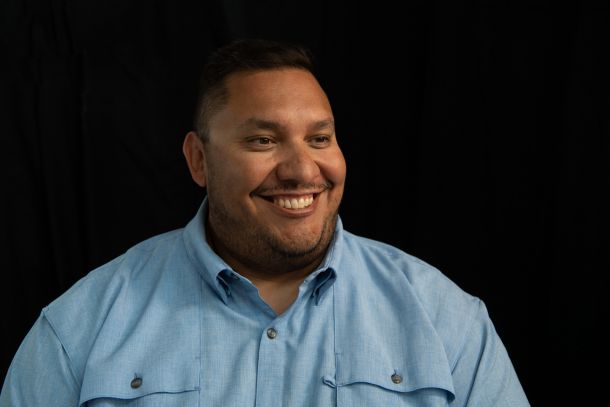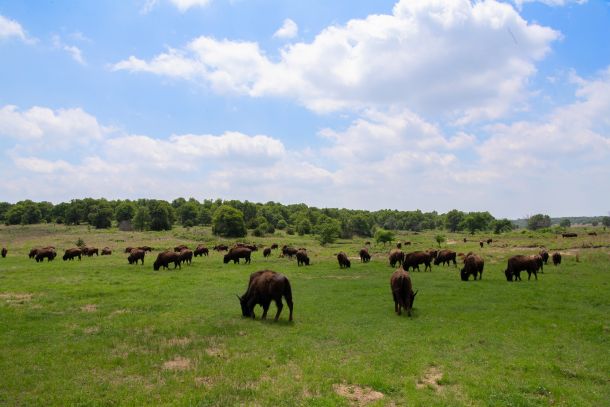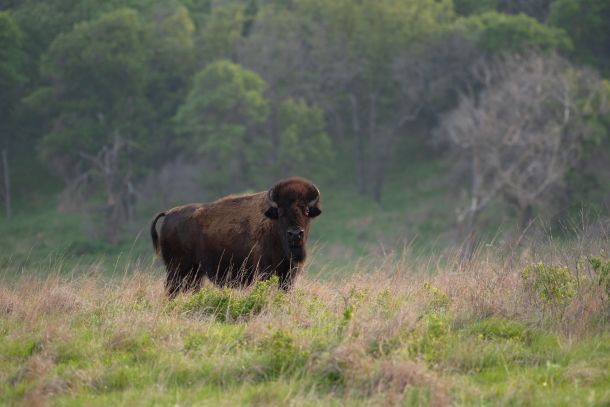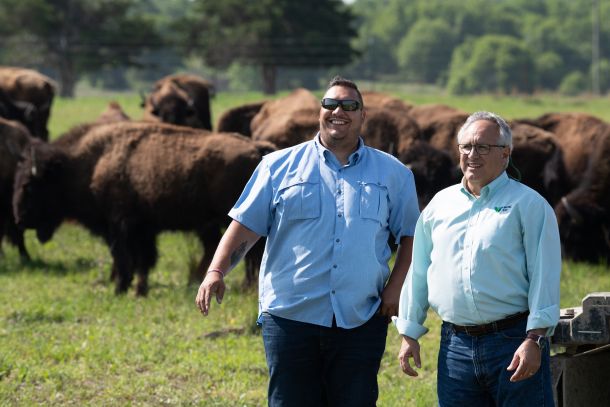This piece comes to us from the Wildlife Conservation Society (WCS). To honor Native American and First Peoples Heritage Month, WCS and Nature are sharing this story of nature and conservation.

Jason George, Business Development Specialist for the Osage Nation Department of Natural Resources. Photo credit: Julie Larsen Maher © WCS.
On June 5, 2006, the Osage Nation and Osage Tribal Council exercised their sovereign authority and transferred governmental authority to a constitutional or tripartite government. The following year, the Osage Nation government began creating a 25-year strategic plan called the Will of the People.
Among several subjects identified in that plan were specific measures to support and expand cultural preservation and education; increase the Nation’s land base; institute self-management of our natural resources, and develop a comprehensive tribal water and land use policy to promote preservation and conservation of native species significant to Osage history.

American bison restored to native lands grazing in a pasture in Osage County, Oklahoma. Photo credit: Julie Larsen Maher © WCS.
In the 15 years since we developed that plan, the Osage Nation has made significant strides in accomplishing these initial goals. The Real Estate department purchased or received 62,392 acres of land to increase the land base. Our Natural Resource department is in the process of conducting a full biological inventory of the Osage Nation Ranch and plans to continue a similar inventory of all the Nation’s trust and restricted properties.
The Natural Resource department is also researching the Osage Nation Environmental Code for the future Osage Nation Environmental Protection Act. This law will help to ensure the protection of the Nation’s environment, culture, history and ecology.
As part of that effort, the Natural Resource department and the Osage Nation Ranch established a conservation herd of bison, free of cattle genetics, that currently numbers more than 200 head. Our bison management plan will maximize the conservation herd and the acreage available for them to thrive.

An American bison on the Osage Nation Ranch. Photo credit: Julie Larsen Maher © WCS.
It is amazing how things in life can come around full circle. Sometimes it can take more than 100 years, but it still comes full circle. In 1907, when the American bison was nearly extinct, fifteen bison left New York City’s Bronx Zoo by train for the foothills of Southern Oklahoma in an effort to preserve one of the most iconic keystone grazers of the plains. Those bison went on to spark the restoration of the species in Oklahoma and beyond.
In 2022, six more bison left the Bronx Zoo, in a truck and trailer this time, bound for the plains of Northeast Oklahoma, Osage County specifically, to boost and improve the herd size, health, and genetic diversity of the Osage bison herd.

Jason George (left) with Bronx Zoo Vice President and General Curator Pat Thomas (right) observing the bison herd on the Osage Nation Ranch after the Bronx Zoo-bred bison integrated with the conservation herd. Photo credit: Julie Larsen Maher © WCS.
All of the efforts put forth by the tribal nations with the assistance from various zoos, colleges, state wildlife departments, and other groups are helping lead the charge of reclamation and protection of the land and its inhabitants. We are all on the same team in an effort to create a better future by improving and preserving the precious natural resources and wildlife that are all around us.
Coming 115 years after the original transfer of bison from the Bronx Zoo to Oklahoma, the recent infusion of bison of conservation value into the Osage Nation herd bridges two centuries of conservation to protect a species that has long been at the heart of our culture. We have been humbled, honored, and proud to be a partner with the Bronx Zoo in that effort.
Like the echo of buffalo hooves stampeding across the Great Plains, the Bronx Zoo’s bison restoration program reverberates across the entirety of North America.
In many ways, the bison of North America and the great Native Nations share a similar story arc. Once free, wide-ranging, and numbering in the millions, we are both now only shadows of what we once were. The return of bison to the Osage people will have a profound effect on our efforts to reclaim not only our culture but a way of life.
Just as our bison brethren are making a comeback and starting to grow strong, Natives of this land are doing the same. We are asserting our rights to protect our lands, our water, and our people that depend on those natural assets in our own way. These efforts are paving the way for future generations to experience, enjoy, and protect the bounty of our resources.
